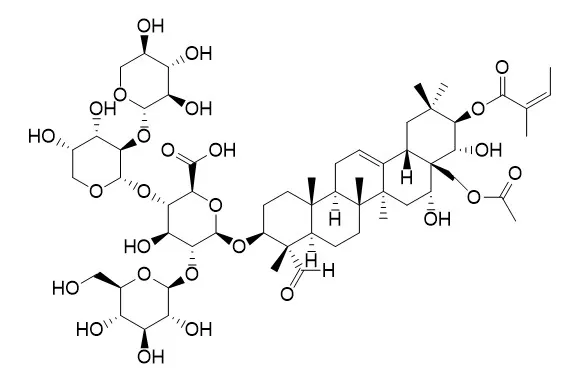| In vitro: |
| Fitoterapia. 2013 Jan;84:321-325. | | Phytochemical analysis of the triterpenoids with cytotoxicity and QR inducing properties from the total tea seed saponin of Camellia sinensis[Pubmed: 23266730] | | The tea seed triterpene saponin (TS) from Camellia sinensis was found to exhibit better antitumor activity in vivo in S180 implanted ICR mice and QR inducing activity for hepa lclc7 cells respectively compared with the total tea seed saponin (TTS), hydrolysate of the TTS and tea seed flavonoid glycosides (TF). By bioassay-guided isolation, the TS fraction was separated and seven major components were purified and identified as theasaponin E1 (1), Theasaponin E2 (2), theasaponin C1 (3), assamsaponin C (4), theasaponin H1 (5), theasaponin A9 (6), and theasaponin A8 (7), among which compounds 4 and 5 were isolated from this genus for the first time. The antitumor bioassay of the isolated compounds showed that compounds 1, 2 and 3 exhibited potential activities against the human tumor cell lines K562 and HL60. Furthermore, compound 1 (the major constituent with a mass content of over 1%) showed significant QR inducing activity with an IR value of 4.2 at 4μg/ml. So it can be concluded that tea seed especially the compound 1 (theasaponin E1) could be used as an antitumor agent and a chemoprevention agent of cancer. The preliminary structure-activity relationship in the anti-tumor activity and QR inducing activity of tea saponins was discussed briefly. |
|
| In vivo: |
| Chem Pharm Bull (Tokyo) . 2000 Nov;48(11):1720-1725. | | Bioactive saponins and glycosides. XVII. Inhibitory effect on gastric emptying and accelerating effect on gastrointestinal transit of tea saponins: structures of assamsaponins F, G, H, I, and J from the seeds and leaves of the tea plant[Pubmed: 11086901] | | Following the investigation of assamsaponins A, B, C, D, and E, four new saponins termed assamsaponins F, G, H, and I were isolated from the seeds of the tea plant (Camellia sinensis L. var. assamica PIERRE), while assamsaponin J was isolated from its leaves. The structures of assamsaponins F-J were elucidated on the basis of chemical and physicochemical evidence and found to be 16,22-O-diacetyl-21-O-angeloyltheasapogenol E 3-O-[beta-D-galactopyranosyl (1-->2)][beta-D-glucopyranosyl(1 -->2)- alpha-L-arabinopyranosyl(1-->3)]-beta-D-glucopyranosiduronic acid, 21-O-angeloyl-22-O-acetyltheasapogenol E 3-O-[beta-D-galactopyranosyl(1--> 2)][beta-D-glucopyranosyl(1-->2)-alpha-L-arabinopyranosyl(1-->3)]- beta-D-glucopyranosiduronic acid, 21-O-angeloyl-28-O-acetyltheasapogenol E 3-O-[beta-D-galactopyranosyl(1-->2)][beta-D-glucopyranosyl(1--> 2)-alpha-L-arabinopyranosyl(1-->3)]-beta-D-glucopyranosiduronic acid, 21-O-tigloyl-28-O-acetyltheasapogenol E 3-O-[beta-D-galactopyranosyl(1--> 2)][beta-D-glucopyranosyl(1--> 2)-alpha-L-arabinopyranosyl(1-->3)]-beta-D-glucopyranosiduronic acid, and 16,21-O-diacetyl-22-O-cinnamoyltheasapogenol B 3-O-[beta-D-galactopyranosyl(l-->2)][beta-D-rhamnopyranosy(1-->2)- alpha-L-arabinopyranosyl(1-->3)]-beta-D-glucopyranosiduronic acid, respectively. The saponin mixture from the seeds of the tea plant was found to exhibit an inhibitory effect on gastric emptying and an accelerating effect on gastrointestinal transit in mice. Theasaponin E1 the principle saponin of the tea plant, showed potent activity, while Theasaponin E2 showed none, so that the position of the acyl groups in the sapogenin moiety is important from a pharmacological point of view. |
|






 Cell. 2018 Jan 11;172(1-2):249-261.e12. doi: 10.1016/j.cell.2017.12.019.IF=36.216(2019)
Cell. 2018 Jan 11;172(1-2):249-261.e12. doi: 10.1016/j.cell.2017.12.019.IF=36.216(2019) Cell Metab. 2020 Mar 3;31(3):534-548.e5. doi: 10.1016/j.cmet.2020.01.002.IF=22.415(2019)
Cell Metab. 2020 Mar 3;31(3):534-548.e5. doi: 10.1016/j.cmet.2020.01.002.IF=22.415(2019) Mol Cell. 2017 Nov 16;68(4):673-685.e6. doi: 10.1016/j.molcel.2017.10.022.IF=14.548(2019)
Mol Cell. 2017 Nov 16;68(4):673-685.e6. doi: 10.1016/j.molcel.2017.10.022.IF=14.548(2019)